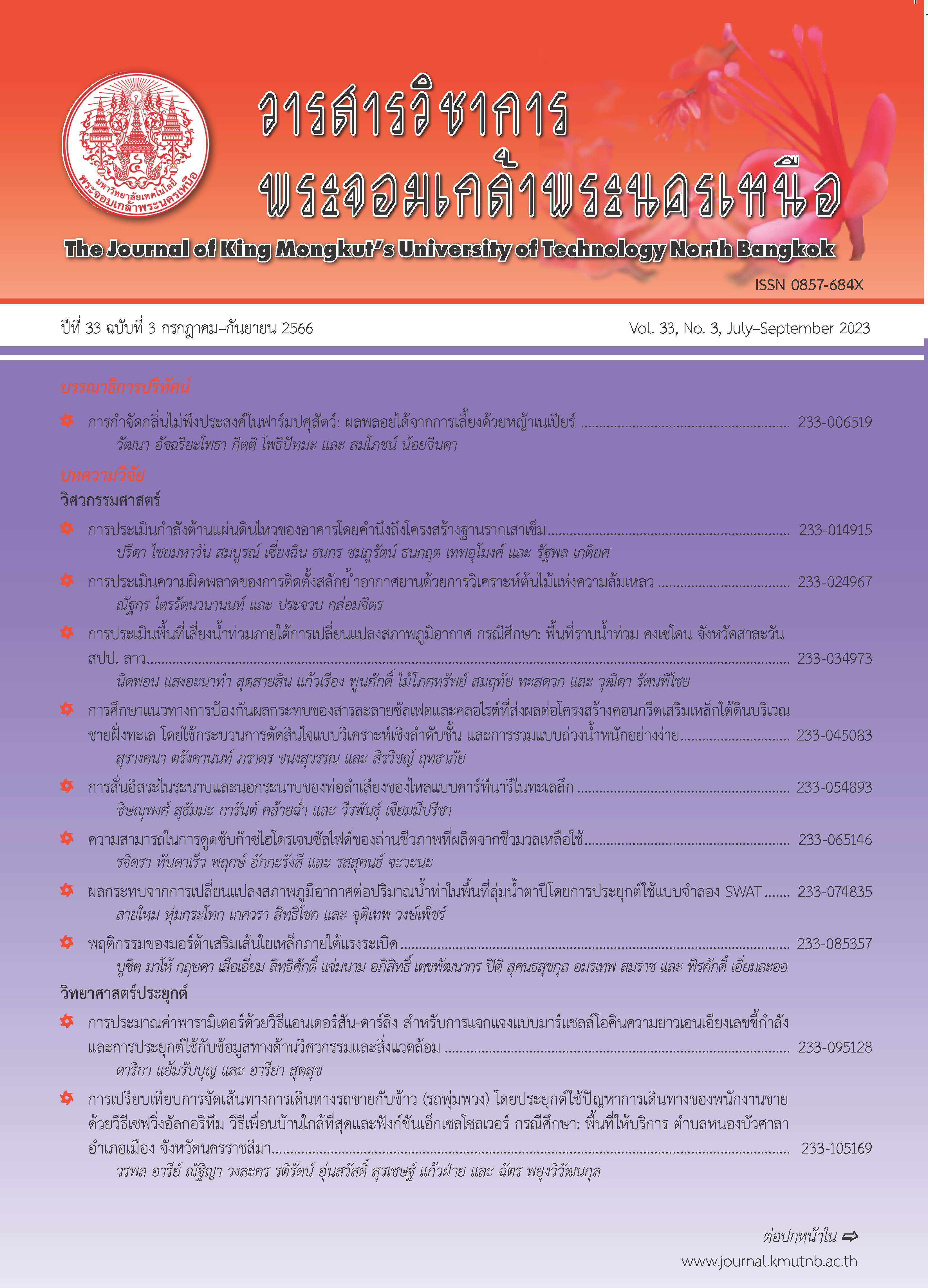การพัฒนาสารเคลือบชีวภาพฐานเซลลูโลสจากเยื่อกาบกล้วยและคุณลักษณะที่ส่งผลต่องานพิมพ์ระบบดิจิทัล
Main Article Content
บทคัดย่อ
วัสดุฐานเซลลูโลสได้รับความสนใจจากนักวิจัยอย่างกว้างขวาง เนื่องจากเป็นนวัตกรรมที่มีความปลอดภัยต่อสิ่งแวดล้อม และสามารถพัฒนาได้จากแหล่งวัตถุดิบที่หลากหลาย งานวิจัยนี้มีวัตถุประสงค์เพื่อพัฒนาสารเคลือบชีวภาพฐานเซลลูโลสที่สกัดได้จากเยื่อต้นกล้วยน้ำว้า (Musa sapientum L.) ชนิดไม่ฟอกขาว (Unbleached Cellulose-based Coating; UBCC) และชนิดฟอกขาว (Bleached Cellulose-based Coating; BCC) สำหรับเคลือบบนวัสดุพิมพ์ประเภทกระดาษและศึกษาคุณลักษณะที่ส่งผลต่องานพิมพ์ระบบดิจิทัล โดยสารเคลือบชีวภาพฐานเซลลูโลสประกอบด้วยเซลลูโลสที่สกัดจากเยื่อกาบกล้วยที่ความเข้มข้นร้อยละ 10 โดยน้ำหนัก ร่วมกับเมทิลเซลลูโลส และกลีเชอรอล ร้อยละ 10 และ 5.0 โดยน้ำหนักของเซลลูโลสตามลำดับ โดยทำการเตรียมและเคลือบลงบนกระดาษ และทดสอบด้วยการพิมพ์ระบบพิมพ์อิเล็กโทรโฟโตกราฟี (เลเซอร์) และอิงค์เจ็ท ผลพบว่า สารเคลือบ UBCC มีสีเทา ขณะที่ BCC มีสีขาวครีม โดยทั้งสองมีค่าความหนืดใกล้เคียงกันผลคุณสมบัติหลังการแห้งตัวพบว่า UBCC และ BCC ที่ความหนาชั้นฟิล์มเปียก 120 ไมโครเมตร เมื่อแห้งสารเคลือบทั้งสองมีความหนาชั้นฟิล์มแห้งที่แตกต่างกัน คือ 19.34 ±0.58 และ 23.70 ±1.47 ไมโครเมตร ตามลำดับ ขณะที่ BCC มีสภาพพื้นผิวที่เรียบกว่า UBCC อย่างเห็นได้ชัดเมื่อตรวจสอบด้วยกล้องจุลทรรศน์อิเล็กตรอนแบบส่องกราด ทั้งนี้ BCC ส่งผลให้ค่าความมันวาวเพิ่มขึ้นแปรผันตรงกับความหนา ตรงข้ามกับ UBCC ที่ลดลงอย่างต่อเนื่อง โดยที่ความหนาชั้นฟิล์มเปียก 120 ไมโครเมตร ค่าความมันวาวของสารเคลือบทั้งสองมีค่าเป็น 4.07 ±0.15 และ 1.53 ±0.06 GU ตามลำดับ และ BCC ยังแสดงขอบเขตสีของงานพิมพ์ได้ดีกว่ากระดาษไม่เคลือบอย่างชัดเจนเมื่อทดสอบพิมพ์ด้วยระบบพิมพ์อิงค์เจ็ท แต่แสดงผลใกล้เคียงกับกระดาษที่ไม่ผ่านการเคลือบเมื่อพิมพ์ด้วยระบบพิมพ์เลเซอร์ นอกจากนั้น คุณสมบัติด้านสี และการเก็บรายละเอียดของตัวอักษรและเส้น ยังรายงานไว้ในบทความนี้ด้วย
Article Details

อนุญาตภายใต้เงื่อนไข Creative Commons Attribution-NonCommercial-NoDerivatives 4.0 International License.
บทความที่ลงตีพิมพ์เป็นข้อคิดเห็นของผู้เขียนเท่านั้น
ผู้เขียนจะต้องเป็นผู้รับผิดชอบต่อผลทางกฎหมายใดๆ ที่อาจเกิดขึ้นจากบทความนั้น
เอกสารอ้างอิง
H. Kipphan, Handbook of Print Media, Berlin: Springer, 2001.
M. Sharma, R. Aguado, D. Murtinho, A. J. M. Valente, A. P. M. De Sousa, and P. J. T. Ferreira, “A review on cationic starch and nanocellulose as paper coating components,” International Journal of Biological Macromolecules, vol. 162, pp. 578–598, 2020.
F. An, K. Fang, X. Liu, C. Li, Y. Liang, and H. Liu, “Rheological properties of carboxymethyl hydroxypropyl cellulose and its application in high quality reactive dye inkjet printing on wool fabrics,” International Journal of Biological Macromolecules, vol. 164, pp. 4173–4182, 2020.
S. Sibaly and P. Jeetah, “Production of paper from pineapple leaves,” Journal of Environmental Chemical Engineering, vol. 5, pp. 5978–5986, 2017.
P. Tumthongkhum, N. Buataengtansakul, R. Chollakup, A. Jarerat, S. Netramai, and W. Kongtud, “Development of paper from oil palm empty fruit bunch and mesocarp, and paper mulberry fibers, with chitosan coating,” RMUTP Research Journal, vol. 13, no. 2, pp. 37–49, 2019 (in Thai).
K. Dhali, M. Ghasemlou, F. Daver, P. Cass, and B. Adhikari, “A review of nanocellulose as a new material towards environmental sustain ability,” Science of the Total Environment, vol. 775, pp. 145871, 2021.
P. Samyn, A. Barhoum, T. Öhlund, and A. Dufresne, “Review: nanoparticles and nanostructured materials in papermaking,” Journal of Materials Science, vol. 53, pp. 146– 184, 2018.
L.V. Hai and Y. B. Seo, “Properties of nanofibrillated cellulose prepared by mechanical means,” Cellulose Chemistry and Technology, vol. 52, no. 9, 741–747, 2017.
S. Khankaew and A. Photirattanasangchai, “UVA-monitored, cellulose-based binder colorimetric security printing ink,” The Journal of KMUTNB, vol. 31, no. 3, pp. 156–166, 2021 (in Thai).
M. B. K. Niazi, Z. Jahan, S. S. Berg, and Ø. W. Gregersen, “Mechanical, thermal and swelling properties of phosphorylated nanocellulose fibrils/PVA nanocomposite membranes,” Carbohydrate Polymers, vol. 177, pp. 258–268, 2017.
R. H. Leach and R. J. Pierce, The Printing Ink Manual, 5th ed. Melbourne: Springer, 2009.
F.J. Francis, “Colorimetry of food,” in Physical Properties of Food, Westport: AVI Publishing, 1993, pp. 105–124.
M. Bertalmío, Vision Models for High Dynamic Range and Wide Colour Gamut Imaging, London: Academic Press, 2020, pp. 131–155.
X. Cao, Y. Wang, H. Chen, J. Hu, and L. Cui, “Preparation of different morphologies cellulose nanocrystals from waste cotton fibers and its effect on PLLA/PDLA composites films,” Composites Part B: Engineering, vol. 217, 2021.

